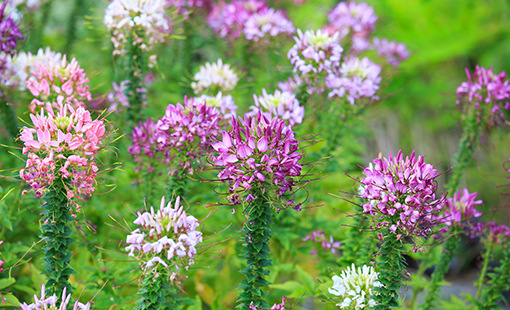
Cleome AKA Spider Flowers
Cleomes aren’t the most popular annuals sold at nurseries, and it might be because they look rather weedy as young seedlings. Unlike pert marigolds or dazzling New Guinea impatiens, cleomes usually do not start blooming until they are well established in the garden. Though they can be planted in early spring, many gardeners opt for a late fall seed sowing directly in garden soil.
Care
Averaging three to four feet in height, cleomes provide a welcome tall focal point in the annual garden, where compact bedding plants tend to rule. The pink, purple, white, and lavender flowers do not emit a noticeable fragrance, yet hummingbirds, butterflies, and hummingbird moths are drawn to these flowers all summer long.
Cleomes easily start from seed in the garden and tend to be hearty from germination, growing quickly. Once started, the plant seems to take care of itself. What is more, the upright stalks need no staking if they are growing in full, bright sun. This plant shrugs off pests and diseases.
Light
Cleome flowers grow best in full sun, and shady conditions can make them grow too tall and topple over. If you start with transplants, blossoms will appear from early summer until the first frost. Gardeners who grow cleome from seed usually see the first flowers in mid- to late-June, depending on the climate.
Soil
Cleomes do best in average garden soil or rich, well-drained garden loam.
Water
Once established, cleomes are drought-tolerant, making them a welcome addition to the xeriscape garden. Add a three-inch layer of organic mulch to their planting bed, and you will decrease their water needs even further.
Temperature & Humidity
For successful germination, cleome seeds need higher-than-normal temperatures. Fluctuating day/night temperatures are essential for optimum germination. During the day, temperatures should range from 80 to 85 degrees Fahrenheit; nightly temperatures should stay between 68 and 70 degrees Fahrenheit. The humidity should be from 90 to 100 percent. As the plant grows, the temperatures can be lower, from 75 to 80 degrees Fahrenheit during the day and 60 to 65 degrees Fahrenheit at night. Cleomes are not frost-tolerant.
Fertilizer
If using good, well-drained soil and mulch, no fertilizer is necessary.
Varieties
From the 180 varieties of cleomes, here are a few that are popular among gardeners for their color and growth habit:
- ‘Helen Campbell’ is a variety that offers pure white flowers and needs very little care.
- ‘Linde Armstrong’ is a compact 12- to 18-inch, sterile, and thornless variety with pink, rose, or mauve blooms.
- ‘Rose Queen’ is fragrant and eye-catching. This cultivar comes in shades of purple, white, cherry, and rose. Be mindful of the spines growing at the base of each leaf.
- ‘Sparkler Bush’ is a unique hybrid plant that has a bushy look with white or pink flowers.
- Spirit™ series offers two to four foot tall plants with a better branching growth habit, but it has thorns and sticky foliage. Blooms can be white, pink, or lavender.
Pruning
Cleomes need very light pruning. Snip off dead leaves or damaged areas during the growing season. If the plants are spindly right before planting, trim them back by half to encourage new growth once they are in the ground.
Potting & Repotting
You can grow cleome in large containers, but choose a compact variety like the Sparkler™ series for best results. Combine your potted cleomes with a mounding flower like vincas and a trailing flower like petunias for a full and lush container.
How to Get Cleomes to Bloom
Fortunately for the home gardener, cleomes are quite easy plants to grow and maintain. A good watering habit will help establish them; once established, they are drought-resistant and respond well to pruning. Deadheading cleomes will encourage new growth while preventing it from self-seeding, thus keeping the garden neater.
Common Problems
Cleomes are surprisingly resistant to pests and quite resilient against common plant diseases. Mildew and rust might become a problem if the plants are too crowded; thin the plants to avoid this problem. If the soil is not healthy, the plants will not be as healthy as they could be, and that will attract insects that could shorten the life of the plant.
FAQ
-
How long can cleomes live?
Cleomes are annual plants, which means they live only for one season. When they die back in fall, plant new seeds, or wait until spring to sow seeds as soon as the ground can be worked.
-
What are alternatives to cleomes?
The casual form of cleomes makes them well-suited to the cottage garden or naturalized meadow. Mix cleomes with zinnias, cosmos, black-eyed Susans, salvia or celosia. These plants thrive in the same sunny conditions and moderate irrigation that cleomes love.
-
Can cleomes grow indoors?
It’s possible to start cleomes indoors and later transplant them to the garden. However, their tall growth habit and need for direct, full sun make it tough to successful grow them indoors.
Information courtesy of TheSpruce.com

 Adams Fairacre Farms
Adams Fairacre Farms